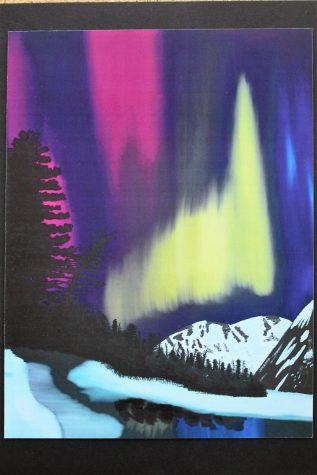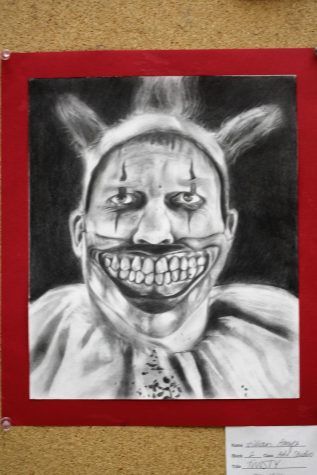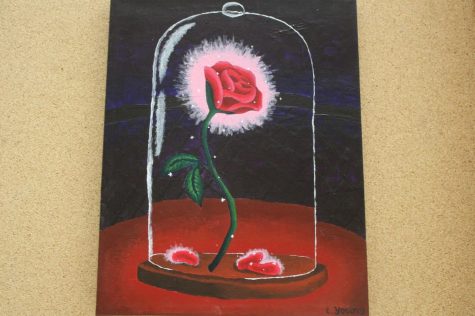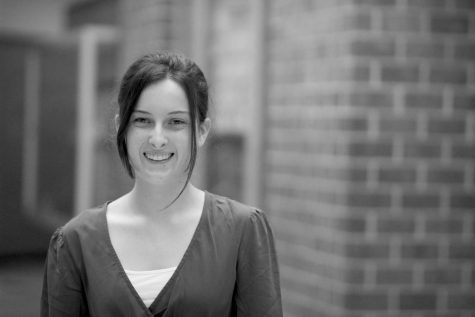Tomorrow’s Artists Creating Today
A look into Advanced Studio Art
Senior Sydney Dickerson’s Nature’s Profiles
November 19, 2018
Pencils scratch across paper in unison as students learn the basics of shading and proportion. Twenty-six pairs of hands mold clay into coil pots to get a glimpse into the basic principles of pottery. Next door, senior Paige Johnson works on a different type of project, one where she is in complete control. Using inspiration from an Instagram post, she mixes ink with water and layers it onto a board to create a piece conveying her chosen theme of the semester–light in dark places.

Johnson’s ink storm
Johnson’s masterpiece is just one of the unique projects created in Advanced Studio Art.
“I’ve realized over the past years I’m not very good at making things realistic, so I decided to

Johnson’s On the Border
try something a little bit different,” Johnson said.
“I wanted to choose something that just shows the beauty of the world. It shows all the ways there’s natural light through different things like the Northern Lights or light coming in through a cave and showing all the rocky textures.”
This project challenged Johnson through her chosen theme and method. Experimenting with colors, layering and mixing on a regular board was how she started. On her final draft, she added lighter colors first and slowly added more intense colors with more water to create different ring effects. The final step: creating lightning bolts with white ink–the light in a storm
Johnson is just one of 21 students in Advanced Studio Art. The smaller class size helps students become comfortable with each other, allowing for the frequent sharing of creative ideas.
“When you’re sitting there, everyone is quiet and everyone is working really hard, senior Jillian Amys said. “You can feel the energy. No one is there to mess around.”
During the course, students create seven to eight projects, and they get about two weeks for each project. The projects vary year to year depending on the group of students. This year during the first semester, students created an accordion fold book with six pieces, a self-portrait including foreshortening (to show depth) and a reduction print. During the second semester, students create four independent projects that are meant to be connected through a common theme or media. Their work is compiled into a digital portfolio which involves taking photos of artwork, editing those photos and writing an artist statement. The portfolio can be submitted to colleges for admissions or scholarships. Projects are graded on originality in process, concentration and subject matter, technical proficiency and expression.
Amys drew her inspiration from horror.

Amys’s TWISTY
When searching for subject matter for her project, she came across an image of Twisty from American Horror Story. She was drawn to the desperation show through purely his eyes. This led to her researching the character and eventually, drawing him. Amys worked on this drawing, in and out of class, every day for two weeks.
“It’s this twisted but real side of the human condition,” Amys said. “The idea of horror is very intriguing to me because it sends so much shock into you. I feel like if I can get my art out there and have people see it, they might be able to experience what I feel about horror movies and appreciate it like I do. I love being able to replicate a persona you see someone expressing through a character they wouldn’t normally be comfortable expressing.”
Senior Elli Young chose Disney as her theme, incorporating iconic scenes from her favorite movies into her art. Her most recent project was a painting of the enchanted rose from Beauty and the Beast. The planning process began on notebook-sized painting paper paper-sketching and mapping out colors. Then, whole days were dedicated to testing out new ideas on the rough draft to determine the best composition for the final masterpiece.

Young’s Beauty and the Beast
Keeping a sketchbook is required for students. It is meant to be used as a brainstorming space to test out different media and come up with compositions for projects. From there, they choose their strongest composition and practice using the materials they will need.
“I want the students to find their own creative voice and style- what will set them apart from others,” art teacher Jennifer Hoss-Miller said. “I try to challenge them to try different things, especially in his/her sketchbook. Take risks – try something you haven’t tried before because you’ve been scared or unsure of your success – you’ll never know if you don’t try.”
Advanced Studio Art prepares students for future careers in art, but also teaches important skills such as problem solving, thus providing the participants with challenges to help them grow.
“This class allows me to use something that I don’t usually get to use in school life because school is usually about following the rules and order, but in art you don’t have to,” Williams said. “You can let loose and try new things. If I mess up on something, I have to find a way to solve it. Not everything is pen and pencil, so you can’t really erase your mistakes. You have to figure out how to use it in your art.”
Even if these students don’t pursue a career in art, this class will provide them with skills applicable to any career and masterpieces to enjoy for the rest of their lives.







